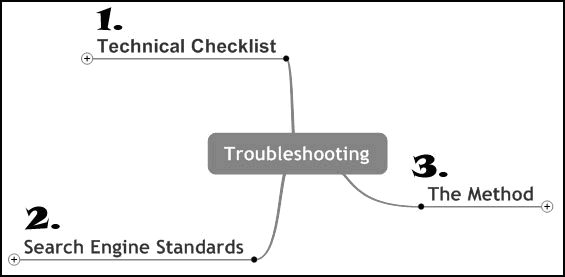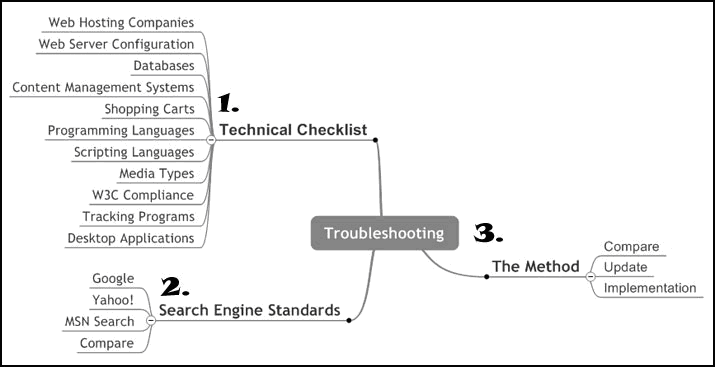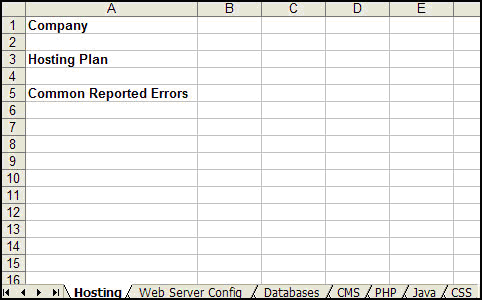BACK TO BASICS: SEO Competitive Research, Part 8: Troubleshooting Techniques
by: Bradley Leese, August 2006
By now, you now have successfully completed each step outlined in
this Competitive Research series. You have identified, measured,
collected, analyzed and strategized but there is a small problem: you
are still nowhere near a level playing field with your primary
competitor. This article aims to teach you the how and why of
troubleshooting those last barriers standing in your way to the
improving your search engine rankings across all major search engines.
Part 1: Review
Each Competitive Research article in this series has been written to
address a specific element of the process of competing head-to-head with
a major competitor. Here’s a brief recap of the major steps towards
achieving top search engine rankings. Follow each article to uncover and
clarify exactly what each competitor is doing and how to overtake their
precious rankings one keyword at a time. So far in the series we have:
Identified Competitors:
After you have identified targeted high activity keyword phrases, you
will have properly narrowed down the most important competitors. (Read:
Part 2: Identifying Competitors)
Measured Parameters:
You have visited the top sites and made a clear inventory of all the
most relevant parameters that your competitors are excelling in.
Accurately document your own site against that of your true competitors.
(Read: Part 3: Measurable Parameters)
Collected Data:
Collected and organized data now provides insight into the flux of
competitor sites. You can begin to understand how this data might form
trends that may be worth analyzing. (Read: Part 5: Data Collection)
Analyzed Data:
Analyzing the collected data trends will provide clear evidence of
the most valuable information sources to a website’s success in the
search engines. Analyze changes and pay close attention to any major
shift across competitor sites. (Read: Part 6: Data Analysis)
Developed A Site Strategy:
You have surveyed the land, weighed the most potent parameters and
decided on which elements your primary competitor is using to the
greatest effect. (Read: Part 7: Site Strategy)
Part 2: Troubleshooting
You have done the research and followed each recommended step to no
avail. How do you get over that last barrier and completely dominate
your competition?
When all else fails and high keyword ranking still remain out of
grasp, it is time to return to the source of all knowledge by looking
within. Instead of looking out to others to answer how to fix your site,
begin by looking inward into the specifics of your own site. Understand
exactly who you are as a member of your community online. Before
exploring the larger meaning of company identity, return to the problem
at hand: Why has my site not received high SERP rankings?

Example 1: Three Troubleshooting Steps
Ready: Evaluation
What makes your site tick? Document each specific technology that you
use to place your site live on the internet for the search engines to
index. If you are not currently aware of the technical specifications of
your site you will never know if they are getting in the way of your
site getting fully indexed by the search engines. Make a technical
checklist of your own site so that you can verify that you are not your
own worst enemy.
Aim: Google, Yahoo! and MSN Standards
You may remember in Part 2: Measurable Parameters
that we discussed the importance of going to each search engine and
documenting each variable that the search engines highlight in their
webmaster guidelines. It is time to revisit this process for each of the
major search engines. Create a thorough guide for each engine
documenting in detail each issue that is addressed, noting the elements
that deal with the specific technical specification on your site. Often
when your rankings are stagnant or frozen the obvious culprit is that
you have been flagged or penalized for breaking major search engine
violations. By creating a definitive checklist you are ensuring that all
your bases have been covered.
Fire: Methodology
Return your seat to the upright position and once again consult the
Bruce Clay methodology. The troubleshooting methodology is straight from
BC gospel which states that each element should be measurable and
implementation should always be carefully tracked.
Technology Checklist
There are many different ways to effectively construct a site to
achieve high search engine rankings. Using static HTML, ASP or PHP will
not improve your rankings alone. It depends on how the code is written
and how it interacts with the database. There are many ways to build a
successful website that complies with all search engine requirements.
To prepare for possible technical issues, create a checklist of all
the elements being used in the construction and maintenance of your
site. Be thorough in the process and consider all the elements of how
your site is constructed and maintained.
Here is a list of elements to consider:
- Web Hosting Companies (Ipower, Aosoft )
- Hosting Plans (Virtual, Dedicated)
- Web Server Configuration (Apache, IIS)
- Databases (MySQL, SQL, Oracle)
- Content Management Systems (Mambo, TeamSite, CoreMedia)
- Shopping Carts (OSCommerce, X-Cart Gold, Paypal, Google Checkout)
- Programming Languages (HTML, PHP, ASP)
- Scripting Languages (JavaScript, CSS)
- Media Types (Flash, Jpg, Java Applets)
- W3C Compliance (HTML, XML, Robots.txt)
- Tracking Programs (Analytic Codes, Usability tracking)
- Desktop Applications (Dreamweaver, Front Page, Adobe GoLive)
Carefully document all the factors and the technical specifications,
using all published specifications. Collect available data from the
official forums and support pages that highlight common search related
issues. Seek out all the known issues relating to errors with search
engines or commonly reported problems. Place your emphasis on error
discovery rather than uncovering specific solutions. It is crucial to
locate the best long term solutions and not rely on quick fixes or
temporary patches.
Remember to take Murphy’s Law into consideration when considering the use of new technologies on your site: If anything can go wrong, it will.

Example 2: Three Troubleshooting Categories–Expanded
Organize this documentation so that you can easily reference it
throughout the remainder of the troubleshooting process. Create a
spreadsheet document with a tab for each technically specific element
that plays into the operation and maintenance of your website.

Example 3: Technical Checklist Spreadsheet
By first documenting technical related issues throughout your site
you can make the process of evaluating search engine standards as it
relates to your site’s relationship to the search engines. Open the
spreadsheet and document each instance in which search engines address
your individual technical needs. Remember to include the originating
URLs in notes so that you can return to each appropriate documentation
element.
Search Engine Standards
All search engines are built on a foundation of very specific rules.
Each of the major search engines (Google, Yahoo! and MSN Search) have
been very good about documenting the factors that they value in a “good”
website. Document each element with as much technical detail as
possible and refrain from discounting even the smallest detail. Make
special notation of the factors that they “forbid” as there maybe a
penalty attached. Ignoring these warnings may result in negative
repercussions to search engine rankings.
Use the following search engine resources to collect up-to-the-minute documentation:
 |
Google Help Center |
|
Google Official Blog |
|
 |
Yahoo! Help Center |
|
Yahoo! Official Blog |
|
 |
MSN Help Center |
|
MSN Official Blog |
Documentation should always be obtained from webmaster guidelines or
their official blog, rather than from forums and non-official blogs.
Eliminate the distraction of outside opinion and focus on the task at
hand. The reality is that this process that will provide the greatest
insight into ranking for that search engine. Beyond the written text,
you will see the structure and values that that each search engine has
towards site relevance and requirements for high search engine rankings.
Create a separate spreadsheet to document search engine standards:

Example 4: Search Engine Standards Spreadsheet
This process should strip away the myths from the methods on how a
site is evaluated and indexed by a search engine. Stop following the
crowd and being dependent on outside influences (unofficial forums and
blogs) and go to the source.
In the beginning, the volume of documentation can be daunting, but
each element has a profound implication on the standards that a search
engine is structured on. Create a document like that used to track data
parameters and make clear documentation that can be reviewed with
consistent frequency to make sure you implementing the most up to date
elements.
In the construction of this documentation for each of the major
search engines, make sure to cross reference the similarities and
differences between engines. Make specific notation as to which engines
are more strict or lenient on specific factors. Use this list to outline
specific standards in which to structure and plan the future growth of
your site. You will realize that after making these specific notes that
you can most efficiently rank for all major search engines across the
spectrum without baring rankings from another.
The Troubleshooting Method
Compare
Compare the elements discovered in the technical checklist and the
search engine standards. Document and categorize each major element and
prioritize its importance (Short or Long term Priority). Compare this
list to your data completed in Part 3: Measurable Parameters, Part 5: Data Collection and Part 6: Data Analysis and analyze and identify which elements are critical, and which are forbidden and possibly harmful to search engine rankings.

Example 5: The Troubleshooting Method
Update
Identify the elements that are specific to your site and the
currently implemented website technology. Evaluate each element to
verify that there are no issues that relate specifically to the
technology implored on your site. If there are relevant issues, mark the
category and assign a specific deadline. Place the priority in a list
and update your site strategy to account for the improvement and
contribution of additional information to support this new category or
item.
Implementation
Systematically begin removing bad and ugly elements. Begin by
removing one element a week from the top priority elements. Continue
collecting and analyzing data. If there aren’t major drops in SERPs as
elements are removed, proceed with caution until all the questionable
sections have been updated.
Review the documentation and list of priorities identified during
this troubleshooting process. Measure twice and cut once. In search
engine optimization there is no mysterious process to getting search
engine rankings; it’s simply a matter of meticulous recordkeeping and
small moves carefully measured. There is no sense in completing 10 tasks
only to find out that your rankings begin dropping, as there would be
no way to tell which change was responsible for the drop and all would
have to be removed. Remember to pace the implementation of changes with
strict attention paid to any ranking loss or ranking gain.
Troubleshooting is by far the most tedious and nebulous of all the
steps in competitive research, however, don’t become discouraged. By
following all the steps outlined in this Competitive Research series,
you will be able to identify and better the techniques that your
competitors are using to reach the top of the SERPs. Happy optimizing!










